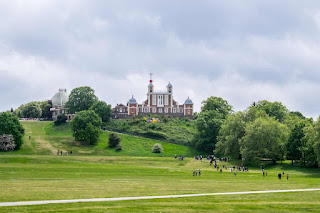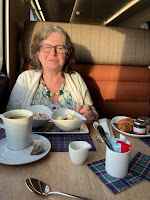We decided to attend the qualifying rounds on Tuesday, with two friends who also live locally. Parking free at nearby Richmond Park was straightforward followed by a shortish walk to the grounds.
Safety precautions at the grounds meant that accessing the tournament took a few minutes after which there were few problems.
There is a limit of 2000 spectators so the grounds were rather less crowded than the main Wimbledon Tennis grounds. People were friendly, including the main Wimbledon steward who who chatted to us for five minutes whilst awaiting break for court one tennis. He told us that one year they managed to persuade Heathrow Airport to alter the take off and landing patterns for aircraft which limited airplane noise.
We were fortunate to watch the match between Roland Garris (Paris) star Lois Boisson. Ms Boisson reached the semi finals in Paris (on which see further below) but had to qualify to enter Wimbledon as she had insufficient points to enter directly. We watched her match with Carson Branstine of Canada and like most of the others in the packed stand of viewers, were astonished when the Canadian won.
Interestingly changes from past years which presumably apply to the main Wimbledon tournament, include use throughout, of the Hawk Eye camera which previously usually only showed pictures when one of the players called for such to be done. Now close calls were displayed almost at once. Another change is the discontinuance of the use of linesmen and women presumably as a result of the increased use of Hawk Eye even in the qualifying matches.
The BBC reported: The 22-year-old rose to 65 in the world following her fairytale run to the French Open semi-finals as a 361st-ranked wildcard at the French Open.
However, the cut-off to enter the main (Wimbledon) draw is about six weeks before the tournament - when Boisson was still ranked outside the top 400.
That meant she had to go through qualifying, where on Tuesday she suffered a 6-2 6-7 (1-7) 6-4 defeat by Canada's world number 197 Carson Branstine.
We enjoyed lunch together near the tournament viewing screen.
After the interesting afternoon, we stopped enroute back to our cars, at the tea shop near by to the car parking area in Richmond Park and enjoyed tea and cake in the sunshine.

























No cattle truck type experience as on planes, nor traffic jams as on roads.
Whereas as indicated earlier, nearly all the other comments were critical, for example a longer one reading:
When the new Caledonian Sleeper carriages were introduced in 2019, they included en-suite rooms and other upgrades. However, these features came at the cost of reducing space elsewhere in the train, the berths and corridors are claustrophobically narrow.The new Caledonian Sleeper carriages are noisier and less comfortable, made from lighter modern materials with less effective suspension, and poor acoustic insulation compared to the old sleepers. Worn out tracks, maintenance problems exacerbate rattling and vibrations, loose fittings inside carriages add to the noise. The older trains were heavier and better tested for smoother travelling, making them quieter and more enjoyable. The current carriages prioritise efficiency and capacity over passenger comfort, which might explain why fewer people choose to travel on this train again.
Possibly many today moan more about many things, than did the generation born before, during or just after after WWII when there was eg still food rationing in the 1950s.
For the remainder of this blog post there are posted pictures of the Caledonian Sleeper.
Details of our very interesting and enjoyable stay in Aberdeen will hopefully,follow next week.